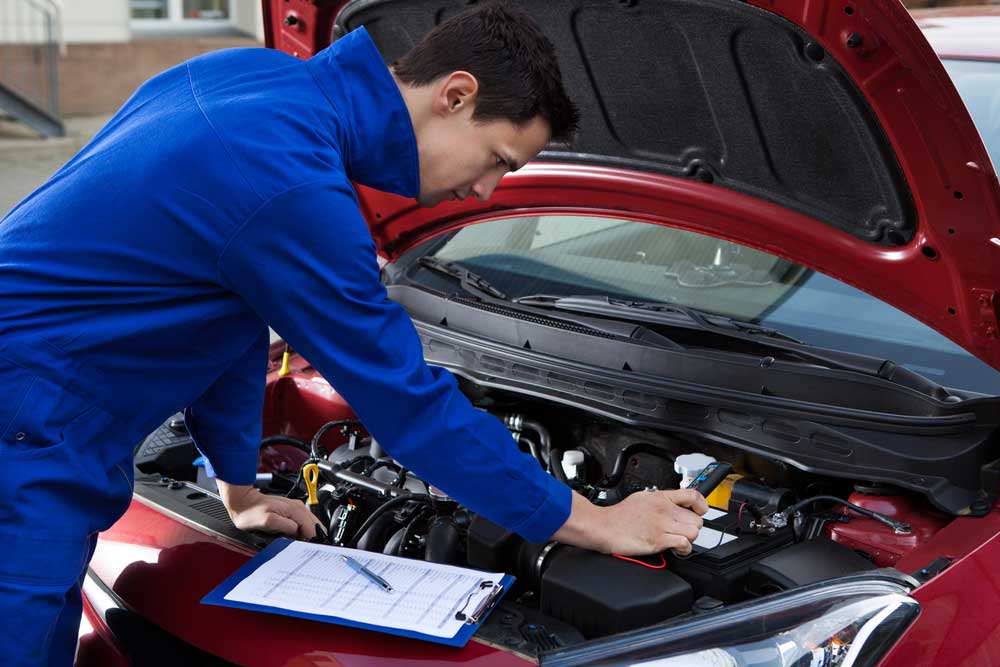
Many reasons could cause your car to stall while you are driving but not start back. You could have problems with your car's fuel tank, ignition system or mass air flow sensor. Don't panic. Many of these problems are easily fixed by replacing one or two components. This problem can be extremely frustrating so keep reading.
Problems with your catalytic conversion
If your car stalls while driving but starts back after a few seconds, it may be time to have your car's catalytic converter checked out. Catalytic converters work to remove exhaust from cars. However, if they are not working properly, this can cause engine problems. Here are some warning signs.
Poor compression. The mixture of fuel/air may be too strong if it is blocked. The car may jerk as a result. You can clean the catalytic conversion cleaner to remove the blockage. These products can be costly, so your mechanic might recommend them. It is better to take the car to a mechanic for proper diagnosis and repair.

Problems with your fuel pump
A faulty fuel-pump is one of most common problems for cars. A faulty fuel pump can cause a variety of problems, such as worn fuel pumps or defective ignition. If your car stops moving but then restarts, it is time to check the fuel pump. Regularly changing your fuel filter will prolong the life of your fuel pump. It will also prevent clogging. The fuel pump may need to be replaced if the car stops moving but restarts normally.
In addition to malfunctioning ignition, the fuel pump can also fail to send the correct amount of fuel to the engine. When you turn the ignition, the fuel pump relay supplies fuel to the engine. This can cause whining and buzzing sounds. Sometimes the relay does not deliver enough fuel to the engine. Your car may stall on the highway but restart after restarting. Before your car loses its ability to start, a faulty fuel pump relay can give you warning signs. If your car stops starting after you drive it, it may be a problem with the fuel pump relay.
Problems with the ignition system
Car stalling can be a frustrating problem. It could be caused by many things. Faulty ignition modules are usually responsible if the problem occurs while driving. It can stop the engine, or it may be due to a faulty mass air flow sensor. A faulty mass air flow sensor can detect too much or too little air, and shut the engine off. The problem can occur intermittently, or it may be a combination of these two issues.
Faulty fuel filter or fuel can also cause your car to stall. Clogged fuel filters can cause your car to stall. A carb cleaner can be used to clean it if it's blocked. If it's not, you can install a new carburetor. These solutions may not work if the ignition system is the problem. If these solutions fail, your mechanic may recommend that you check the engine control or crankshaft position sensors.

Problems with the mass flow sensor
When your car stalls while driving but starts right back up, you may be experiencing problems with the mass air flow sensor. This is a sign that the mass air flow sensor has not been reading accurately. You can test the mass flow sensor by driving the car without it. The computer will make a guess about the airflow and give you better results. The computer will use the guess to calculate the fuel mixture and may even give you a better mix than the actual amount.
If any of these symptoms are present, your car's mass-air flow sensor may be defective. This sensor monitors the amount of air entering and exiting the combustion chamber. If this sensor fails to function properly, your car could not receive the right air-fuel mix and may run lean/rich. If you suspect this problem, it's time to get it checked.
FAQ
What can I do to fix my car as an hobby?
Take up a hobby in car repair if you have an interest. You can repair them, buy their parts, sell them, or just have fun with them. If you are looking for something more, it would be an excellent hobby.
But it is not easy to turn this into your full-time occupation. This requires dedication and hard work. It will also require a large amount of investment.
You may not be able to have an emotional connection with cars unless there is a valid reason.
What is the average time it takes to become a mechanic?
A mechanic is only an expert if they have years of experience. A professional mechanic will teach you how to fix cars.
You will have to spend time in a garage learning about cars and mechanics. You will need to be familiar with mechanical engineering books about mechanics, car design, and other topics.
Additionally, you will need to attend an auto school.
The most important thing is to start early. To learn about automotive technology, don't wait to be older. You can get certified as a mechanic by getting started right away!
What qualifications do you need to be a truck-mechanic?
Although you don't need to have any formal qualifications, your experience working with trucks and engines is invaluable. You are a valuable asset as you can quickly diagnose and solve problems efficiently.
Additionally, you have a solid knowledge of diesel technology that will enable you to determine what parts are necessary to repair our vehicles.
Is it difficult to find a job as a mechanic in the automotive industry?
It is possible. Garages often advertise their jobs online and people just apply because it seems fun. You can apply for several places to see if they are accepting student applications if you want to get your foot in their door. Another option is to ask family members and friends if anyone works in this industry. You might be able to refer someone.
What is the distinction between a mechanic or an automotive technician?
Although they may be similar, they are not identical. Both a mechanic and an automotive technician can repair cars.
A mechanic must be skilled in manual dexterity and able to complete simple tasks quickly. They should be able to accurately diagnose problems and repair them efficiently.
An automotive technician must be more technically proficient than a mechanic. They must be capable of reading blueprints and using tools such as drills, wrenches, etc.
They must also be able to carry out complex procedures safely. They should also be familiarized with the different types of engines as well as electrical systems.
They must also be capable of understanding how parts interact.
The result is that a mechanic often earns less than an auto technician. There are many job opportunities in both.
Does it matter where I go to college?
Non, really. In terms of getting into the auto industry, there is no distinction between colleges. Some schools have better programs than others, so you might want to look elsewhere if your goal is something more specialized.
Statistics
- According to the BLS, total auto technician employment is expected to exceed 705,000 by 2030. (uti.edu)
- Apprentice mechanics earn significantly less hourly than mechanics who have completed training, with a median wage of approximately $14.50 an hour, according to PayScale. (jobhero.com)
- The U.S. Bureau of Labor Statistics (BLS) reports that the job outlook for automotive service technicians and mechanics is expected to decline by 4% from 2019 to 2029. (indeed.com)
External Links
How To
How to correctly diagnose your vehicle for repairs
Before you can determine if your car requires repairs, it's important to first analyze the symptoms. These steps will help you diagnose your car properly.
-
Check engine lights. You should inspect the dashboard lights, such as the engine light indicator and the oil pressure gauge. Also, check the battery light indicator. You may have a problem with your vehicle if any of the indicators are flashing for more than a few days.
-
Take a look at the treads. If the tires are worn out, they could cause problems with handling and braking. You should inspect the treads on your wheel. They should be clean and smooth. The best way to do this is to remove the wheels and take them off. You can check the tread wear with a flashlight.
-
Monitor the level and consistency of your brake fluid. You must always monitor the level of your brake fluid. This ensures that your brakes work properly. Your brakes may fail if the brake fluid level drops.
-
Test the suspension system. A suspension system is designed to absorb vibrations and shocks. This suspension system provides greater control and smoother acceleration and deceleration. A suspension problem can cause your vehicle to feel wobbly and shake uncontrollably. To test whether your vehicle has a suspension issue, try putting weight on the front or rear axle and observe the movement.
-
Examine your steering column. The steering column is used to link the steering wheel with the rest of vehicle's components. Sometimes, steering columns are damaged by accidents. If yours feels loose or shaky, you should replace it.
-
Observe the exhaust pipe. Exhaust pipes help move gases from the combustion chamber to the atmosphere. Exhaust pipes that are cracked or leaking can allow harmful fumes to enter your cabin. Additionally, your tailpipe should be fixed immediately if it is bent.
-
Look under the hood. If you see anything unusual, take a look under the hood. There could be fluid leaking from your engine. You should also contact a professional technician if there is an unusual odor coming from the engine compartment.
-
The air filter should be checked. The vehicle's outside environment may cause the air filter to collect dust and debris. A dirty filter can lead to a poor vehicle's performance. Replace your air filter regularly.
-
Check the fan belt. Your vehicle's fanbel is what connects the engine and the transmission. The engine will not turn if the fan belt breaks. It is very easy to replace your belt. You only need a screwdriver or pliers to replace your belt.
-
The radiator hose and hoses should be checked. The radiator hose carries water from the radiator to the engine. If it becomes cracked or damaged, it can leak hot liquid onto the engine. You only need a pair of needle-nose pliers and a small wire brush to repair the hose.
-
You should inspect the windshield wipers. Windshield wipers use electricity for snow and rain removal. If they stop functioning, they can leave streaks in your window glass. Simply change the washer oil to fix the problem.
-
You should inspect the cables. The battery cables provide power for the electrical systems in your car. If you are replacing batteries, disconnect the negative cord first. Failure to do so can damage your alternator.
-
You should check the headlights. Headlights illuminate the road ahead of you. They can make it difficult to see if they stop working. Check the bulbs to see if they've burned out.
-
Be sure to check the lights. Lights warn other drivers when you approach them at night. If one doesn't work, it could distract you and lead to an accident.
-
Make sure you check your brakes. Before you collide with another vehicle, brakes will slow down the car. If your brakes aren't working properly, you may lose control and crash into other cars.
-
Change the oil. Oil keeps your engine lubricated. It helps prevent metal parts from wearing out too quickly. It is recommended to change the oil once a month.